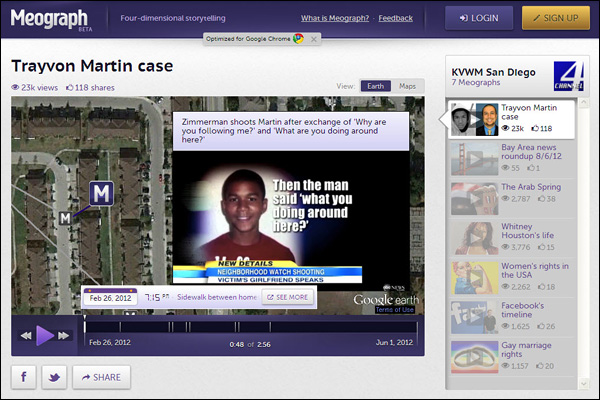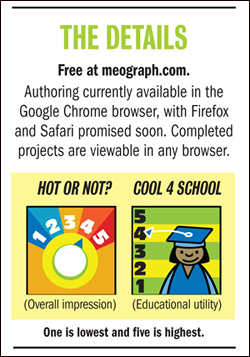
Looking for a fresh way to create rich educational presentations? Meograph helps users create and share uniquely dynamic interactive projects, incorporating Google Maps and Google Earth to generate a story time line, which can be enhanced with images, video clips, text, audio narration, and links for more in-depth information.
Currently in an early Beta release, Meograph is already a promising way for educators to fashion presentations on any topic where a visual grasp of time and place is central to understanding, making it especially suitable for social studies/history content.
Creating a Meograph presentation is totally intuitive. The Web-based program asks users to answer three basic questions: What happened, when did it happen, and where? It then automatically plots that information on a time line and presents it in chronological order via the viewer’s choice of Google Maps or Google Earth (download required), flying around the globe, displaying where each event took place in time. Creators can add still images or up to 15 seconds of any YouTube video to enhance their story, and record up to 10 seconds of narration from within the browser. To add longer narration, you can record using a third-party app such as Audacity and import the MP3 file. Viewers can elect to watch Meographs in chronological fashion or select points on the time line, hop around, and click “See More” links to further explore a topic.
 While the following topic may not be your cup of tea, I chose to get my feet wet with Meograph by creating a presentation on the early roots of punk rock. Electing to begin in 1964—with the formation of the proto-punk band the MC5 in the suburbs of Detroit—I soon had Meograph whizzing over to New York City in the mid 70s, then jetting to London to illustrate how the musical movement cross-pollinated within the next decade and a half, peppering my presentation with band images and album art, plus short concert snippets via YouTube (see video below). Just three weeks old when I tried the application, Meograph enabled me to open a chat window and get prompt responses to my questions and also to provide feedback that, the company says, will inform rapid updates to the new service. Indeed, Meograph seems genuinely eager to hear from early-adopting educators like us.
While the following topic may not be your cup of tea, I chose to get my feet wet with Meograph by creating a presentation on the early roots of punk rock. Electing to begin in 1964—with the formation of the proto-punk band the MC5 in the suburbs of Detroit—I soon had Meograph whizzing over to New York City in the mid 70s, then jetting to London to illustrate how the musical movement cross-pollinated within the next decade and a half, peppering my presentation with band images and album art, plus short concert snippets via YouTube (see video below). Just three weeks old when I tried the application, Meograph enabled me to open a chat window and get prompt responses to my questions and also to provide feedback that, the company says, will inform rapid updates to the new service. Indeed, Meograph seems genuinely eager to hear from early-adopting educators like us.
So you should definitely play with Meograph. It could become a great presentation and project tool that would sure beat static PowerPoints (groan) or, even worse, poster projects (really, just shoot me) as a 21st-century assessment. Sure, thinking in four dimensions (facts, multimedia, interactivity, and context) is tricky, so Meograph is something that may have to be seen to be fully understood and appreciated. That’s why I recommend that you check out a polished sample presentation at meograph.com/demo.
Educators can use Meograph to create presentations that are perfect for sharing on interactive whiteboards, across social networks, or embedded in websites. Easy enough to use, Meograph could also be assigned to secondary students as a medium for research-project assessments in a cutting-edge, Web-based format that combines the viral appeal of both video and infographics in a modern mashup that teens are sure to get excited about.


